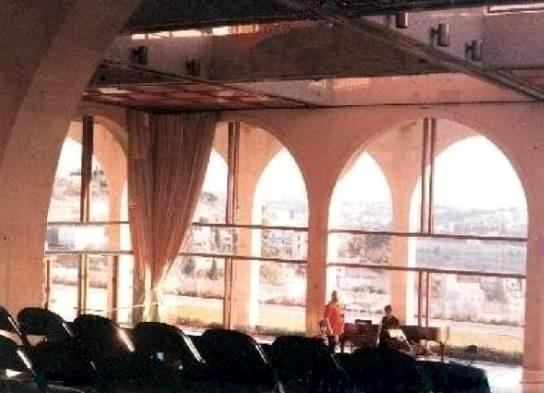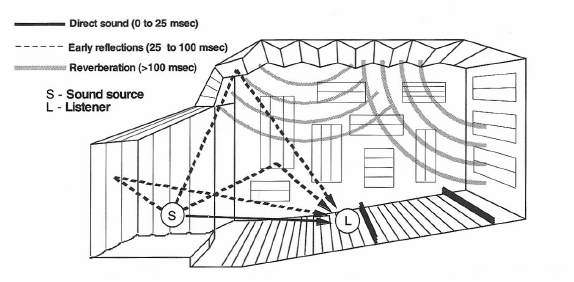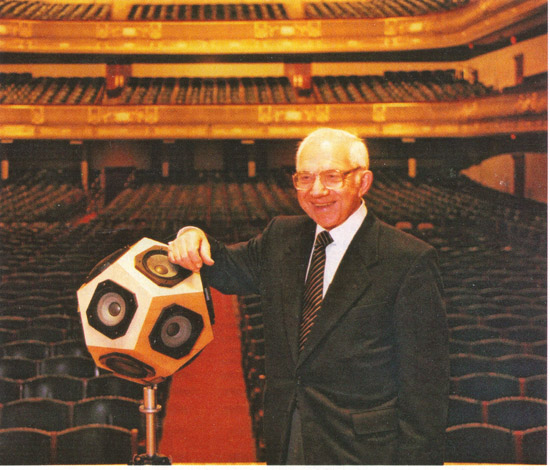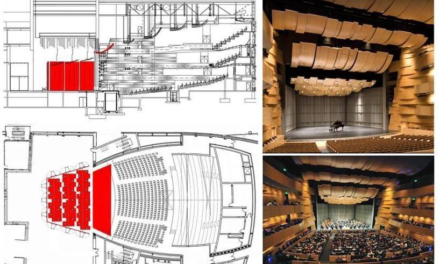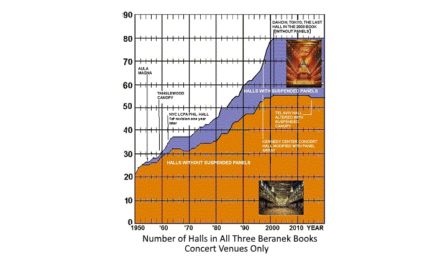Editor’s Note: This blog post, presented by noted acoustical consultant David Klepper, offers advice on the use of glass in performance spaces equipped with a pipe organ. Klepper shows that, properly selected and applied, glass does not compromise the desirable reverberant qualities of the space.
15 June, 2021
Glass has been used successfully for wall and ceiling surfaces for rooms intended for music performance, without compromising the reverberant qualities of these rooms. Two examples are the Los Angeles Crystal Cathedral and the Concert Hall at Brigham Young University’s Jerusalem (Israel) Center for Near-Eastern Studies. (See photograph.)
Sound-Reflection and Sound-Isolation
A single pane of ordinary window glass will transmit, and not efficiently reflect, very-low-frequency sound. But laminated glass, as used for shatterproof automobile windshields, can provide isolation and reflection efficiently1. 3/8-inch or 9mm laminated glass, one inch or 25mm glass, ¼-inch or 6mm transparent flexible mastic as used in windshields, and 1/4-inch or 6mm glass, 7/8-inch or 21mm total thickness, will give performance even better than two-inches of heavy wood.
Glass Swell-Boxes and Swell-Shades
With proper design, sufficient open area when swell-shades are open, the sparkle of open-pipework sound need not be lost by pipework in swell-boxes. Some contemporary organ builders understand this, and positive divisions within swell-boxes are, on rare occasions, seen in organ specifications. Much more frequent are enclosed choir divisions intended to serve as positive divisions, and great divisions enclosed except for one rank of display pipes. Swell-boxes give the organist additional precise control over dynamics, an ability important when accompanying other musical instruments, especially orchestras. They can also be useful with choirs and congregations.
I hope an organ builder will use this idea for an organ that has the flexibility of all-enclosed divisions, yet uses all the pipework to make a beautiful visual statement complementing the interior architecture. The openings in each box’s wall facing the audience or congregation should be 80% of the wall area or more, with the shades pivoting to right-angles with the wall, and only 1/16th inch or 1.6mm cracks with shades closed.
Chests and Toe-Boards
Once the organ-builder has the tools to cut and bore glass, chests and toe-boards might also be possible, for both artistic and educational purposes. However, ordinary Plexiglas may be a more useful material for these purposes, since its inferior low-frequency sound-reflection characteristics may not be a problem, and it can be cut, bored, and glued with greater ease.
Pipes
Substitution of glass for wood in wood pipes should be easy, and laminated glass may be preferable to single thicknesses for certain voices, bass pipes in particular. Substitution for certain portions of both
reed and flue, metal pipes, seem impossible, and even use of glass for the tubular portions may require considerable experimentation. However, this might prove worthwhile. Available data suggests glass
thickness would be four times that for a lead pipe with the same acoustical characteristics.2 The pipe tubes would not use laminated glass.
Notes:
1. Marshall Long, Architectural Acoustics, Elsevier, Burlington, MA; San Diego, CA; London, UK, 2005, 2006, pages 339-341, Figure 9.23. There is a Second Edition, 2013, and the page numbers are different. Also, the effect of the two glass-widths being different is not shown, but results in the two architectural projects indicate a benefit.
2. Op. Sic. Page 327, Table 9.1
About the Author
David Lloyd Klepper is currently a student of Rabbinics at Yeshivat Beit Orot, Jerusalem, Israel, having moved to Israel in 1996 from his position as President of Klepper Marshall King, White Plains, NY, Acoustical Consultants, and as Adjunct Professor of Architectural Acoustics at City University, New York City. Before 1971 he was a senior consultant at Bolt Beranek and Newman, starting his consulting career there in May 1957. He received his SM and SB degrees in Electrical Engineering from MIT, and between times served as Assistant Audio-Radio Member of the PsyWar Board at Fort Bragg, NC, during the Korean conflict, leaving active duty as a 1st Lt. He provided acoustical advice for over 200 worship space buildings, including the National Presbyterian Church, Washington, DC, St. Thomas Church Fifth Avenue, New York City, the Capetown, South Africa, Anglican Cathedral, River Road Baptist Church, Richmond, Virginia, Young Israel of Southfield, Michigan, and Boston’s Holy Cross Cathedral. In this capacity, he was a pioneer in application of digital delay and electronic simulation of reverberation in worship spaces, and pew-back speech reinforcement. Publications include 40 papers in professional journals, a coauthor with Professor Kleiner and Father Rendell Torris of the book Worship Space Acoustics, JRosspub.com., and Editor of the two Sound Reinforcement Anthologies of the Audio Engineering Society. He is a fellow of both the Acoustical Society of America and the Audio Engineering Society, past Emeritus Board Certified member of the Institute of Noise Control Engineering, and a member of both the American Guild of Organists and the Organ Historical Society. He also belongs to a number of railroad and public transit interest organizations. You may contact Klepper at ddaveklepper1@gmail.com.

